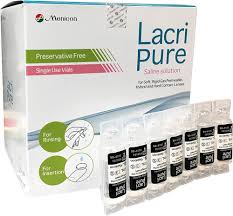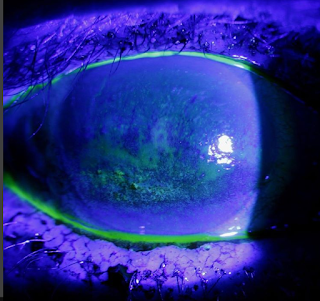Scleral contact lenses can be a complete life-changer for those living with blurry vision, halos, and ghosting due to irregular corneas. Keratoconus, corneal transplants, corneal scars, and even severe dry eye can cause distortion to the smooth symmetric shape of a normal corneal surface, blurring and bending vision into distortion, halos, and glare. A key to scleral contact lens success (clear vision and lasting comfort!), using the right products to both fill and clean your lenses is essential. When you put your scleral lens on, you will always fill the lens up to the brim with preservative free saline. If you put the lens in dry, you will have a massive air bubble in the center of the lens, resulting in very blurry vision. Filling the lens up with saline keeps those air bubbles out of the lens for clear vision, and also keeps the cornea hydrated all day long, which is why scleral lenses can be used to treat severe dry eyes. Whatever saline you fill your lens with prior to insertion will stay there all day long until you remove the lens. Because of that long contact time with the cornea, the saline must be:
Preservative Free
Preservatives are used in multiple purpose contact lens solutions and many eye drops to help kill bacteria. But those preservatives that are toxic to bacteria are ALSO toxic to your cornea. The most common mistake I see patients making with their scleral lenses is going to a local pharmacy, grocery, or big box store and buying preserved saline like Biotrue or a store brand contact lens saline and thinking that would work. Studies show filling your scleral lens with preserved saline causes lens fogging, sloughing of the corneal epithelium (think of this like dry skin cells flaking off- but on your eye!), redness, and discomfort.
Buffered or Non-Buffered
Studies have shown some scleral lens wearers may prefer buffered saline (where the pH of the saline matches the average pH of the tear film which is 7). Borate and phosphate are common buffers used in some brands of preservative free saline, with a goal that if the pH of the saline matches the pH of the tear film there should be less burning or discomfort with lens wear. In real life, the data suggests that buffered versus nonbuffered doesn't make a difference to most patients. In a 2020 study of 27 patients wearing scleral lenses for 3 months, there was no difference in corneal health or comfort for patients using buffered or non-buffered preservative free saline options.
If you find dryness/irritation/burning with scleral lens wear, it may be worth switching from buffered to nonbuffered preservative free saline or vice versa to see if you find one to be more comfortable.
Buffered Preservative Free Saline

PuriLens saline comes in convenient reusable bottles. It can be purchased at Amazon or Walmart 
ScleralFil has single use vials, which is lower risk for contamination than reusable bottles. It can be purchased at Amazon or Walmart.
Non-Buffered Saline
 |
| Lacripure saline is preservative free, buffer free, and specifically designed for scleral lenses. It can be purchased at Amazon or Walmart. |
The following products are not specifically made for scleral contact lenses, but have been used successfully for filling scleral lenses for years before specific scleral products came on the market. Your doctor may also be able to write you a prescription for 0.9% NaCL inhalation vials for filling your scleral lenses, but due to manufacturing and backorder issues, it is increasingly difficult to find pharmacies that stock this product.
 |
| AddiPak saline vials have become increasingly difficult to find. You can only purchase them on Amazon now if you are a verified healthcare provider. The limited supply is due in part to a large recall of AddiPak saline manufactured by Hudson RCL in September 2023 issued by the FDA over concerns that the vials were not sterile. |
 |
| Modudose inhalation vials are still readily available on Amazon. |
Electrolyte Enriched
Nutrifill is a preservative free, pH buffered saline for scleral contact lenses that also has electrolytes (calcuim, magnesium, potassium, and phosphate) meant to mimic the ionic makeup of the natural tear film. In a study of 22 patients comparing filling their scleral lenses with NutriFill versus their habitual saline that did not contain electrolytes, there was statistically significant improvement with NutrFill use in their dry eye symptoms and subjective vision clarity and stability. When visible fogging of the lens fluid was assessed via imaging by the doctor there was no statistically significant difference between the saline options, however.
 |
| Nutrifll can be purchased at Walmart. |
Talk to your doctor about what scleral lens filling solution is recommended for use for your particular lenses and your unique eye chemistry. Never use multipurpose contact lens solution to fill your lenses. As of writing this article, if you can buy it at a grocery store, Target, Walmart (on the shelf) or a pharmacy over the counter - it's not the right saline -- these products are only available to purchase online at this time because only people who wear scleral lenses would ever need these products. Read all of the ingredients carefully, and only use saline that is preservative free to avoid injury and irritation to your eyes!

.png)














.jpg)